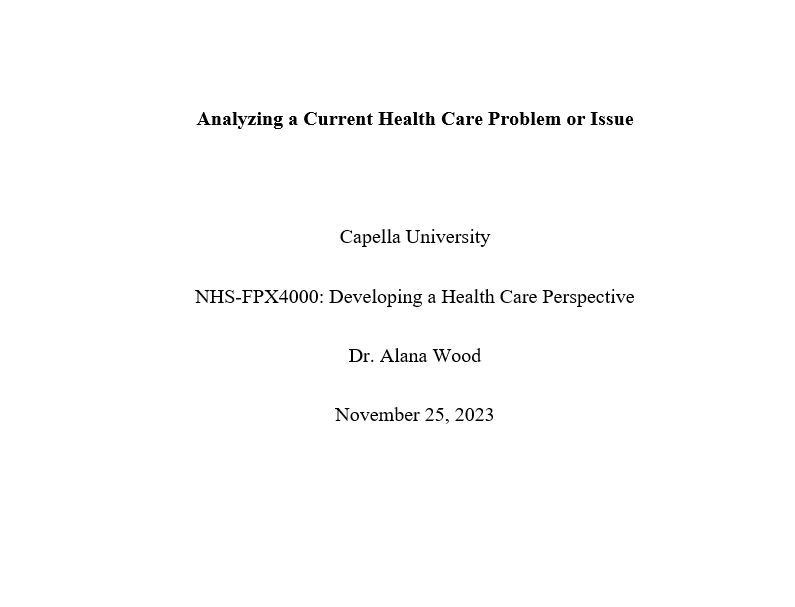Capella University
NHS-FPX4000: Developing a Health Care Perspective
Dr. Alana Wood
November 25, 2023
Analyzing a Current Health Care Problem or Issue
Medication errors are among the issues that jeopardize a brand’s credibility. The preventable events reveal gaps in procedures, systems, communication, and other aspects that jeopardize the quality and safety of patient care. High number of errors reveal the need for timely and sustainable interventions to prevent adverse events such as readmissions, prolonged hospitalization, and additional costs. This paper discusses medication errors as a persistent problem in a complex critical care setting that requires combination of interventions to enhance the quality and safety of patient care.
Medication Errors
Medication errors occur at different points across the care continuum. The events could occur during prescription, transcription, or administration, hence the need for increased vigilance throughout the clinical process. The common causes of medication errors are inaccurate dosage, incorrect diagnosis, malfunctioning equipment, miscommunication, and inadequate staff training and education (Cetin & Cebeci, 2021). Additional causes such as ineligible handwriting, wrong labelling, and misleading instructions increase the frequency and severity of errors (Cetin & Cebeci, 2021).
The multiple risk factors demonstrate the need for increased understanding of the various types and multiple interventions necessary to enhance the quality and safety of patient care. A case example of the adverse implications of medication errors is evident from a mistake by a pharmacy in Mississauga, where a prescription error caused a patient’s death (Institute for Safe Medication Practices, 2017). Investigations showed that the patient received Baclofen, a muscle relaxant drug instead of the recommended Tryptophan, for sleep medication. Further, the patient had almost three times the toxic dose in his system, which revealed the seriousness of the error. The mistake reinforces the need for timely and evidence-based administrative, technical, and human-related solutions to protect patients from emotional, physical, and psychological distress.
Analysis
As mentioned, this paper focuses on a case where a wrong prescription caused death. The scenario involves unsafe mixing of ingredients and an inaccurate dosage that made it challenging to save the patient. For several months, the patient was under medication for a complex sleeping disorder. The prescribed drug was a 3-gram (20 mL) dose of tryptophan administered by mouth (Institute for Safe Medication Practices, 2017). The patient’s family requested a refill of the tryptophan prescription and picked up the prepared medication from the pharmacy. However, the patient died after receiving the medication. Investigations revealed the absence of the recommended medication, caused by a selection error at the pharmacy. Further, the child received an excessive dosage more than 20 times the maximum recommended for a pediatric patient (Institute for Safe Medication Practices, 2017). Investigations showed missing independent verification procedures, unsafe labelling design for both drugs, similar physical appearance of the medications, and the absence of a unique identifier. Further, the pharmacy lacked segregated storage cabinets for oral and topical compounding ingredients, which increased the risk of a selection error. As, multiple interventions became evident to enable the facility address calculation, selection, and mixing errors.
Considering Options
The complexities of medication errors call for a combination of solutions to protect patients from adverse drug reactions and deaths. One recommendation is proactive and consistent independent checks to verify selection of a drug, patient, and dosage (Alghamdi et al., 2019). The move promotes complete adherence to accurate dosage calculation, selection, and mixing of ingredients. A second strategy is reviewing policies and procedures to ensure staff compliance with practice standards.
The review makes health leaders aware of robustness of processes such as independent checks designed to improve accuracies during the preparation stage. Policies, procedures, and safety checklists should be available for staff to follow when preparing and administering medications (Alghamdi et al., 2019). Accurate and complete documentation of each medication administration step is important. The process allows nurses, pharmacists, and physicians to check accuracy of calculations, patient, drug type, and other details before administering medications. Incorporating automated procedures such as bar code scanning is also necessary to enhance accuracies of dosage, patient identification, drugs, and timing (Manias, 2018). Lastly, educational resources such as case studies and role-plays are helpful for complex procedures that require careful attention throughout the medication process. The multiple interventions allow organization to adopt a comprehensive framework for identifying and intercepting errors.
Solution
Medication administration could be a high-risk activity in complex environment such as a critical care unit. The process requires the care team to consider various procedures, standards, and practices. The recommended solution is independent verification. The process enables healthcare professionals to verify details such as dosage, drug type, patient, and timing before administering a drug (Manias, 2018). The goal is to reduce the likelihood of an adverse drug reaction. Independent checks include verifying calculations, selection, and accuracy of dosages and a final check of the final drug, regardless of the knowledge and experience of the person preparing the medication. Independent checks enhance compliance with procedures, policies, and safety checklists designed to maintain a safe clinical environment.
Ethical Implications
Medication errors reveal serious gaps in procedures, policies, and practice standards. Wrong drug selection contradicts ethical principles of beneficence and non-maleficence that requires healthcare professionals to act in a patient’s best interests and minimize the risk of emotional, physical, and psychological distress (Vaismoradi et al., 2021). Issues such as distractions, miscommunication, overriding written policies and procedures, and non-adherence to independent verifications undermine the principle of justice, designed to maintain safe medication administration practices. Thus, complete adherence to independent verification for each critical step makes the care team committed to fulfilling ethical principles. Nurses, physicians, and pharmacists understand their duty of care and the need for consistent responsibility and accountability when preparing and administering medications.
Implementation
Implementing independent verification in each critical step requires an organization to initiate training and education programs for physicians, nurses, pharmacists, and other relevant parties. The process entails using training videos, role-play, and case studies to understand complex medication processes and techniques available to verify accuracy and adequacy of every procedure. The training also provides insights into the evidence-based rationale for the use of independent verifications for calculations, selection, and administration of a drug.
Conclusion
Medication errors have adverse consequences on patients, healthcare professionals, and organizations. Wrong prescription is among the issues that reveal multiple gaps such as the absence of independent verification for each step, inadequate documentation, limited staff training, and poor supervision and oversight. The negative outcomes such as readmissions, prolonged hospitalization, additional costs, and death make independent checks and verification vital for enhancing the quality and safety of patient care.
References
Alghamdi, A., Keers, R., Sutherland, A., & Ashcroft, A. (2019). Prevalence and nature of medication errors and preventable adverse drug events in pediatric and neonatal intensive care settings: A systematic review. Drug Safety, 42, 1423-1436. https://link.springer.com/content/pdf/10.1007/s40264-019-00856-9.pdf
Çetin, S & Cebeci, F. (2021). Perceptions of clinical nurses about the causes of medication administration errors: A cross-sectional study. Florence Nightingale Journal of Nursing, 29(1), 56-64. https://www.ncbi.nlm.nih.gov/pmc/articles/PMC8137725/
Institute for Safe Medication Practices. (2017). Death due to pharmacy compounding error reinforces need for safety focus. Canada Safety Bulletin, 17(5), 1-6. https://ismpcanada.ca/wp-content/uploads/ISMPCSB2017-05-Tryptophan.pdf
Manias, E., Kusljic, S., & Wu, A. (2020). Interventions to reduce medication errors in adult medical and surgical settings: A systematic review. Therapeutic Advances in Drug Safe, 11, 1-28. https://journals.sagepub.com/doi/full/10.1177/2042098620968309
Vaismoradi, M., Moe, C.F., Vizcaya-Moreno, F., & Paal, P. (2021). Ethical tenets of PRN medicines management in healthcare settings: A clinical perspective. Pharmacy, 9(4), 1-10. https://www.ncbi.nlm.nih.gov/pmc/articles/PMC8552074/pdf/pharmacy-09-00174.pdf



